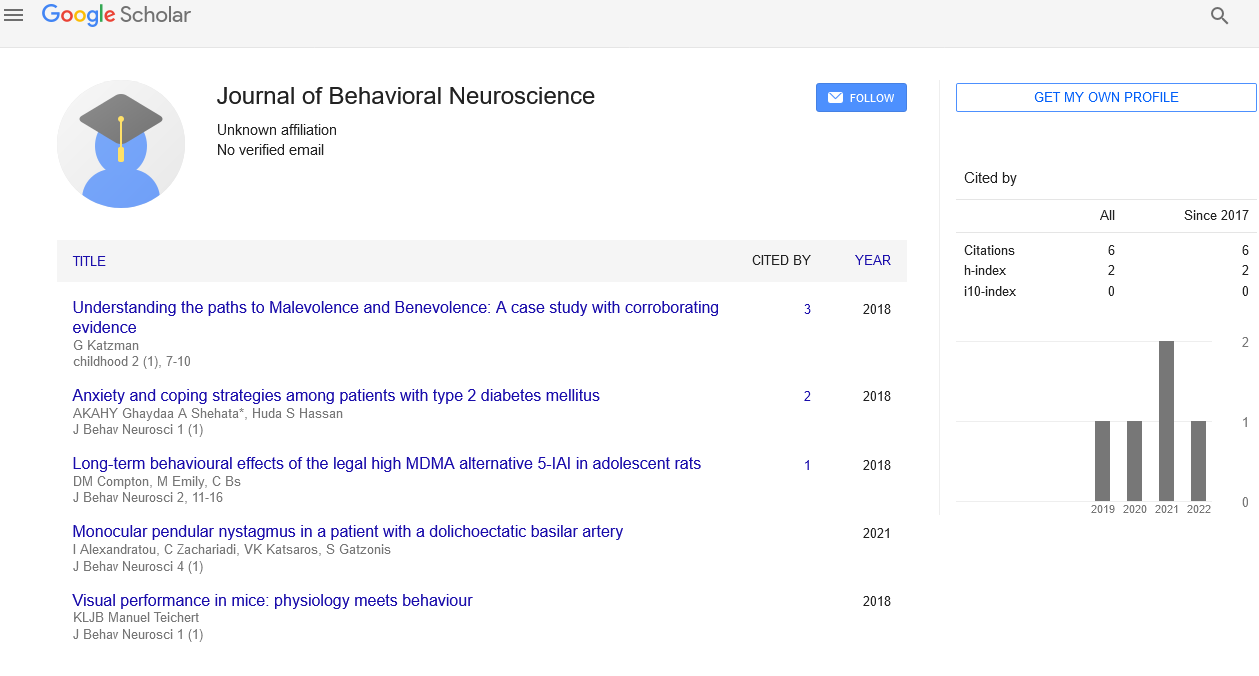Behavioural facets of stroke
Received: 15-Nov-2017 Accepted Date: Nov 17, 2017; Published: 24-Nov-2017
Citation: Dibbanti HR. Behavioural facets of stroke. J Behav Neurosci 2017;1(1):1.
This open-access article is distributed under the terms of the Creative Commons Attribution Non-Commercial License (CC BY-NC) (http://creativecommons.org/licenses/by-nc/4.0/), which permits reuse, distribution and reproduction of the article, provided that the original work is properly cited and the reuse is restricted to noncommercial purposes. For commercial reuse, contact reprints@pulsus.com
Neuroscience is a branch of biology, scientifically studying and understanding nervous system. Behavioural neuroscience is subspecialty of neuroscience devoted to the study of brain-behaviour relationships. Neuroscientists found that dysfunction of the brain can interrupt normal behaviour. Behavioural alterations may see in all ages with wide variety of brain disorders that severely disturb cognition and emotional condition of the individual.
Stroke is unquestionably a privileged disease for behavioural studies, because of its high prevalence and incidence. The part of brain damage is different for different stroke patients and each part of the brain controls a specific function of the body. So behavioural changes are not similar for all stroke patients. Injury occurred to the brain affect the personality, emotional and behaviour aspects of the person [1].
Person with left-brain injury has functionality loss of right side of the body called right hemiplegia. These patients more likely to have problems like motor functions, [Broca’s] aphasia, speech and language. They also become anxious and tense when faced with new folks [2]. A person with right brain injury has functionality loss of left side of the body called left hemiplegia [3]. These patients have difficulty in maintaining rate of movement, judging distance, and other spatial problems. Stroke patients with spatial-perceptual problems have more trouble with self-care. They have problems in driving, walking etc.
Behavioural deficits after stroke may occur with different frequencies: Motor deficits [80-85% of patients], somatosensory functions [40-50%], language or aphasia complications [20-25%], visual problems [15-20%], attention or neglect [25-30%], and memory loss [15-25%] [4-8]. Most of the Stroke patients normally suffer from more than one type of neurological deficit.
Some other important changes seen in people after stroke attack are: Depression, emotional lability, fear, feelings of frustration, social judgment and lack of motivation. Manifestation of depression after stroke has proposed in late half of twentieth century since then the understanding complication of post stroke depression has gained momentum. The possible risk of occurrence of depression after stroke ranges from 25% to 79% [9]. Depression patients suffer irritability, sleeping and eating disorders and also we can observe changes in thinking and way of behaviour with family and colleagues. Increase or gains of emotional changes like inappropriate crying or laughing were commonly observed after stroke attack. Fear is co-morbidity factor with depression in chronic stroke patients. A feeling of frustration is observed after stroke because of difficulty carrying out everyday tasks. Even a minor damage occurred to the brain due to stroke may lead to memory related behavioural changes and thus changes the original character of the person.
Clinical studies conducted on large populations, some important case studies and also neuroimaging findings helps in understanding site specific damage occur to the brain and thus related behavioural changes observed in stroke patients. This type of determining the behavioural changes is called anatomical functional model of behavioural studies. In most of the cases spontaneous recovery from neuro behavioural deficits after acute stroke is thought to be occur in first two to three months of damage occurred irrespective of anatomical feature that got damaged due to stroke [10]. In addition several studies found that recovery from cognitive deficits take longer time period to set the condition.
Even though decades completing after invention of rtPA for stroke treatment. We are still in first step for having therapeutics for stroke recovery. Numbers of preclinical and clinical studies are conducting with plenty of new molecules for inventing new therapeutics for treating brain death but none is worth-full still. Now it is better to investigate therapeutics for treating behavioural changes observed after stroke which may have fruitful outcomes.
REFERENCES
- Mukherjee D, Levin RL, Heller W. The cognitive, emotional, and social sequelae of stroke: Psychological and ethical concerns in post-stroke adaptation. Top Stroke Rehabil 2006;13:26-35.
- Ross ED. The aprosodias. functional-anatomic organization of the affective components of language in the right hemisphere. Arch Neurol 1981;38:561-569.
- Aglioti S, Smania N, Manfredi M, et al. Disownership of left hand and objects related to it in a patient with right brain damage. Neuro Report 1996;1:293-296.
- Ringman JM, Saver JL, Woolson RF, et al. Frequency, risk factors, anatomy, and course of unilateral neglect in an acute stroke cohort. Neurology 2004;63:468-474.
- Nys GM, van Zandvoort MJ, de Kort PL, et al. Cognitive disorders in acute stroke: Prevalence and clinical determinants. Cerebrovasc Dis 2007;23:408-416.
- Appelros P, Karlsson GM, Seiger A, et al. Neglect and anosognosia after first-ever stroke: incidence and relationship to disability. J Rehabil Med 2002;34:215-220.
- Buxbaum LJ, Ferraro MK, Veramonti T, et al. Hemispatial neglect: Subtypes, neuroanatomy, and disability. Neurology 2004;62:749-756.
- Rathore SS, Hinn AR, Cooper LS, et al. Characterization of incident stroke signs and symptoms: Findings from the atherosclerosis risk in communities study. Stroke 2002;33:2718-2721.
- Bartoli F, Lillia N, Lax A, et al. Depression after stroke and risk of mortality: A systematic review and meta-analysis. Stroke Res Treat 2013;2013:1-11.
- Wade DT, Wood VA, Hewer RL (1985) Recovery after stroke-the first 3 months. J Neurol Neurosurg Psychiatry 48: 7-13.





